Comments / Questions (16)
![]() Blandine wrote:
Blandine wrote:
Bonjour, J'ai crocheté le top en taille S, il a bien les bonnes dimensions, malheureusement à l'essayage il est bien en hauteur mais beaucoup trop large en largeur. Il aurait fallu qu'il fasse 72 cm de largeur, dos et devant, pour que ça aille bien. Y'a-t-il un moyen de réduire les côtés pour qu'il soit moins large? Merci! Blandine
10.05.2025 - 21:49DROPS Design answered:
Bonjour Blandine, vous pouvez probablement recalculer d'après l'échantillon et les mesures souhaitées le nombre de mailles qu'il vous faudra pour obtenir les mesures souhaitées. Bon crochet!
12.05.2025 - 07:56
![]() Annie MARTINEZ wrote:
Annie MARTINEZ wrote:
Bonjour, Apres avoir demonte x fois jai reussi a m’en sortir Cordialement Annie Martinez
26.08.2024 - 19:06
![]() Martinez Annie wrote:
Martinez Annie wrote:
Je ne comprends pas les explications bordures devant RANG2de l ’encolure au milieu.. Je ne trouve pas de tuto Cordialement Annie Martinez
26.08.2024 - 14:53DROPS Design answered:
Bonjour Mme Martinez, au 1er rang de la bordure vous avez crocheté des brides tout autour de l'encolure devant. Au 2ème rang, vous crochetez ainsi: (1 bride dans la première maille/la maille suivante, 1 maille en l'air, sautez 1 maille) et répétez de (à) tout le tour (sautez les mailles indiquées pour former l'encolure V). Au 3ème rang, vous crochetez 1 bride dans chaque bride et 1 bride dans chaque maille en l'air (sautez les 4 m centrales pour l'encolure) et au 4ème rang, crochetez de nouveau comme au 2ème rang (sautez les 4 m centrales pour l'encolure). Bon crochet!
27.08.2024 - 09:01
![]() Landre wrote:
Landre wrote:
Bonjour je comprend pas votre explication: «RANG 1: 1-2-1-2-1-2 brides dans la bride suivante côté encolure (on a ainsi 2-3-2-3-2-3 brides dans les 2 brides de la pointe du devant gauche), puis crocheter 3 brides autour de chaque rang de brides en descendant jusqu'à la pointe en bas de l'encolure, à la division de l'ouvrage, crocheter 2 brides entre les deux demi-devants (milieu devant),
12.10.2023 - 22:04DROPS Design answered:
Bonjour Mme Landre, commencez par 3 ml (= 1ère bride), puis 1 ou 2 brides (cf taille) dans la bride suivante en haut du devant (pour avoir 2 ou 3 brides à la pointe du devant gauche), crochetez ensuite 3 brides autour de la 1ère /de la dernière bride de chacun des rangs le long du devant gauche, entre les 2 devants (en bas de l'encolure), crochetez 2 brides écoulées ensemble, vous remontez ensuite le long du devant droit comme pour le devant gauche = 3 brides autour de chaque 1ère/dernière bride le long du devant droit et vous terminez par 2 ou 3 brides en haut du devant droit (comme au début du rang). Bon crochet!
13.10.2023 - 08:40
![]() Katell wrote:
Katell wrote:
Bonjour je bloque je ne comprend pas ce qu'il faut faire a ce moment là :"Tourner. Diviser maintenant le devant, et terminer chaque partie séparément." Est ce que c'est l'idée qu'il faut crocheter une demie partie du devant jusqu'à une bretelle ?
22.07.2023 - 14:29DROPS Design answered:
Bonjour Katell, vous allez maintenant former l'encolure et donc terminer chaque côté séparément: crocheter d'abord le devant gauche puis le devant droit. Bon crochet!
27.07.2023 - 11:51
![]() Rouzic wrote:
Rouzic wrote:
Bonjour, comment s\'explique le fait que côté gauche devant il y ait des mailles coulées mais pas côté droit devant ?\r\nMerci de votre réponse
25.06.2023 - 15:59DROPS Design answered:
Bonjour Mme Rouzic, c'est une technique fréquemment utilisées pour diminuer des mailles de chaque côté; retrouvez-en la démonstration dans cette vidéo; si vous ne souhaitez pas de mailles coulées, il vous faudra couper le fil, sauter le nombre de mailles indiquées au début du rang puis joindre le fil et continuer comme indiqué (sans crocheter les dernières mailles du rang pour former les emmanchures de la même façon de chaque côté). Bon crochet!
26.06.2023 - 09:18
![]() Maggi wrote:
Maggi wrote:
Fin oppskrift! Jeg skjønte ikke hellingen langs kanten, hekle 1-2-1-2, hva betyr det?😊
29.04.2023 - 07:59
![]() Anna wrote:
Anna wrote:
Beautiful pattern thanks Jeanette!!!!! Here are my photos and credit to you, you can use my photos: instagram.com/p/Chw2Zhos9GS/?igshid=YmMyMTA2M2Y=
31.08.2022 - 14:06DROPS Design answered:
Thank you very much Anna, please submit your pictures using that form here to our DROPS Gallery. Thanks again!
31.08.2022 - 15:15
![]() Anna wrote:
Anna wrote:
Beautiful pattern \r\nHere are my photos and credit to you\r\n instagram.com/p/Chw2Zhos9GS/?igshid=YmMyMTA2M2Y=
31.08.2022 - 14:05
![]() Maria wrote:
Maria wrote:
So in every row from the armpit side I start with 1 treble and after decreasing 2 stitches and for every mid side im decreasing 3 stitches and finishing with 1 treble stitch until to have 5? Or I should start with ch 3? Sorry for the spam!!
13.06.2022 - 15:20DROPS Design answered:
Dear Maria, you will decrease on every row: 2 sts towards neck (either after the first stitch (3 chains) at the beginning of the row from neck or before the last treble at the end of the row from armhole towards neck) and at the same time, decrease 1 stitch before the last stitch as the end of the row (from the neck towards armhole) or after the first stich (3 chains) at the beg of row from the armhole towards neck). Happy crocheting!
13.06.2022 - 16:31
Country Cheer#countrycheertop |
|
 |
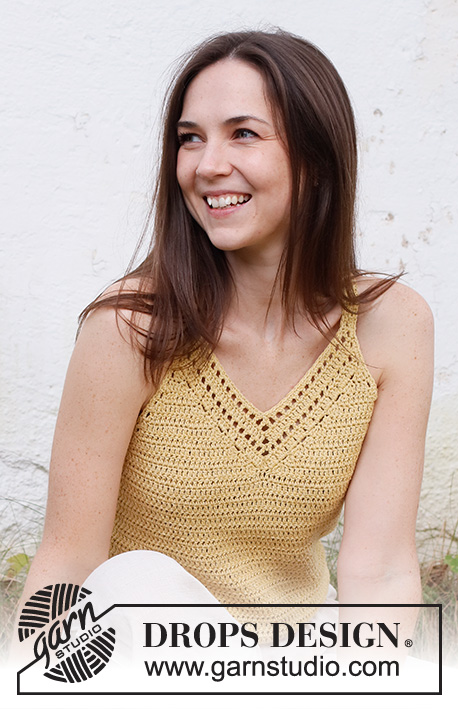 |
Crocheted top in DROPS Belle. Piece is worked bottom up. Size: S - XXXL
DROPS 231-41 |
|
|
---------------------------------------------------------- EXPLANATION FOR THE PATTERN: ---------------------------------------------------------- CROCHET TIP FOR CHAIN STITCHES: If you work at the end of crochet hook the chain stitch will often be too tight. 1 chain stitch should be just as long as 1 single crochet/double crochet is wide. CROCHET INFORMATION: At the beginning of every row with double crochets work 3 chain stitches (they replace first double crochet), i.e. skip first double crochet from previous row. Work last double crochet on row in 3rd chain stitch at the beginning of previous row. At the beginning of every row with single crochets work 1 chain stitch (to replace first single crochet) i.e. skip first stitch from previous row. Work last single crochet on row in 3rd chain stitch from beginning of previous row. INCREASE TIP (applies to sides on front and back piece): Increase 1 double crochet by working 2 double crochets in same double crochet. Increase inside 1 double crochet in each side. Continue the increased stitches in double crochets. DECREASE TIP: WORK 2 DOUBLE CROCHETS TOGETHER AS FOLLOWS: * Make 1 yarn over, insert hook in next stitch, get yarn, make 1 yarn over and pull yarn through the 2 first loops on hook *, crochet from *-* 2 times in total, make 1 yarn over and pull yarn through all 3 loops on hook (= 1 stitch decreased). WORK 3 DOUBLE CROCHETS TOGETHER AS FOLLOWS: *Make 1 yarn over, insert hook in next stitch, get yarn, make 1 yarn over and pull yarn through the 2 first loops on hook *, crochet from *-* 3 times in total, make 1 yarn over and pull yarn through all 4 loops on hook (= 2 stitches decreased). ---------------------------------------------------------- START THE PIECE HERE: ---------------------------------------------------------- TOP - SHORT OVERVIEW OF THE PIECE: Work front and back piece back and forth separately, bottom up. Sew parts together when finished. BACK PIECE: Work 74-80-88-96-108-118 CHAIN STITCHES - read explanation above, on hook size 4 MM = US 6 with DROPS Belle. Work 1 double crochet in 4th chain stitch from hook (= 2 double crochets) - read CROCHET INFO, work 1 double crochet in each of the next 70-76-84-92-104-114 chain stitches = 72-78-86-94-106-116 double crochets. Work 1 double crochet in every double crochet. REMEMBER THE CROCHET GAUGE! When piece measures 8 cm = 3⅛", increase 1 double crochet in each side - read INCREASE TIP! Increase like this every 4-4-4-5-5-5 cm = 1½"-1½"-1½"-2"-2"-2" 4 times in total = 80-86-94-102-114-124 stitches. When piece measures 22-23-24-25-26-27 cm = 8¾"-9"-9½"-9¾"-10¼"-10⅝", work an edge as follows: ROW 1: Work 3 chain stitches, 1 double crochet in 2nd double crochet, * 1 chain stitch, skip 1 double crochet, 1 double crochet in next double crochet *, work from *-* the entire row. ROW 2: Work 1 double crochet in every double crochet and 1 double crochet around every chain stitch. ROW 3: Work 3 chain stitches, 1 double crochet in 2nd double crochet, * 1 chain stitch, skip 1 double crochet, 1 double crochet in next double crochet *, work from *-* the entire row. ROW 4: Work 1 single crochet in every double crochet and 1 single crochet around every chain stitch. Cut and fasten the yarn. FRONT PIECE: Work 74-80-88-96-108-118 chain stitches on hook size 4 MM = US 6 with DROPS Belle. Work 1 double crochet in 4th chain stitch from hook (= 2 double crochets) - read CROCHET INFO, work 1 double crochet in each of the next 70-76-84-92-104-114 chain stitches = 72-78-86-94-106-116 double crochets. Work 1 double crochet in every double crochet. REMEMBER THE CROCHET GAUGE! When piece measures 8 cm = 3⅛", increase 1 double crochet in each side - read INCREASE TIP! Increase like this every 4-4-4-5-5-5 cm = 1½"-1½"-1½"-2"-2"-2" 4 times in total = 80-86-94-102-114-124 stitches. When piece measures 26-27-28-29-30-31 cm = 10¼"-10⅝"-11"-11⅜"-11¾"-12¼", work next row as follows: Work slip stitches over the first 8-8-9-10-13-15 double crochets on row, work until 8-8-9-10-13-15 double crochets remain on row = 64-70-76-82-88-94 double crochets. Turn piece. Now divide the front piece, and finish each part separately. LEFT FRONT PIECE (when garment is worn): Work from the side as follows: Work 1 double crochet in first double crochet, work the next 2 double crochets together (= 1 double crochet decreased) - read DECREASE TIP, work 1 double crochet in each of the next 25-28-31-34-37-40 double crochets, work the next 3 double crochets together, work 1 double crochet in last double crochet. Turn and work from mid front, AT THE SAME TIME decrease 2 stitches towards mid front and 1 stitch towards the side on every row as explained above. Decrease like this way until 5 double crochets remain. On next row work the first 2 double crochets together into 1 double crochet, and the last 3 double crochets together into 1 double crochet = 2 double crochets. Cut and fasten the yarn. RIGHT FRONT PIECE (when garment is worn): Begin mid front where front piece was divided, work 1 double crochet in first double crochet, work the next 3 double crochets together (= 2 double crochets decreased), work 1 double crochet in each of the next 25-28-31-34-37-40 double crochets, work the next 2 double crochets together (= 1 double crochet decreased), work 1 double crochet in last double crochet. Turn and work from the side, AT THE SAME TIME decrease 2 stitches towards mid front and 1 stitch towards the side on every row as explained above. Decrease like this way until 5 double crochets remain on row. On next row work the first 2 double crochets together into 1 double crochet, and the last 3 double crochets together into 1 double crochet = 2 double crochets. Fasten off. CROCHET EDGE FRONT PIECE-1: Work 4 rows with double crochets / double crochets + chain stitch at the top in opening mid front. Begin at the top on left part of front piece, work down towards mid front and up along the side on right front piece. ROW 1: Begin at the top on left front piece. Work 3 chain stitch at the top in first double crochet, 1-2-1-2-1-2 double crochets in next double crochet towards mid front (2-3-2-3-2-3 double crochets have been worked in the 2 double crochets from the tip on left front piece), then work 3 double crochets around every row with double crochets down until where piece was divided, work 2 double crochets between parts (mid front), but work these double crochets together into 1 double crochet, then work 3 double crochets around every row with double crochets up to the top of right front piece, work 2-3-2-3-2-3 double crochets at the top of right front piece = 32-36-38-42-44-48 double crochets on each side of the middle double crochet worked together and 65-73-77-85-89-97 double crochets in total on row. Turn. ROW 2: Work 3 chain stitches, 1 double crochet in 2nd double crochet, * 1 chain stitch, skip 1 double crochet, 1 double crochet in next double crochet *, work from *-* until 3 double crochets remain mid front, skip the next 5 double crochets (the middle of these is the 2 double crochets worked together into 1), work 1 double crochet in next double crochet, * 1 chain stitch, skip 1 double crochet, 1 double crochet in next double crochet *, work from *-* until 3 double crochets remain on row, work 1 chain stitch and skip next double crochet, work 1 double crochet in each of the last 2 double crochets = 60-68-72-80-84-92 stitches. ROW 3: Work 3 chain stitches, work 1 double crochet in every double crochet and 1 double crochet in every chain stitch until 2 double crochets remain towards mid front, skip the next 4 double crochets, work 1 double crochet in every double crochet and 1 chain stitch in every chain stitch the entire row = 56-64-68-76-80-88 double crochets. ROW 4: Work 3 chain stitches, 1 double crochet in 2nd double crochet, * 1 chain stitch, skip 1 double crochet, 1 double crochet in next double crochet *, work from *-* until 2 double crochets remain down to mid front, skip the next 4 double crochets, work 1 double crochet in next double crochet, * 1 chain stitch, skip 1 double crochet, 1 double crochet in next double crochet *, work from *-* until 3 double crochets remain on row, work 1 chain stitch and skip next double crochet, work 1 double crochet in each of the last 2 double crochets = 52-60-64-72-76-88 stitches. Cut the yarn. STRAPS: Begin at the top of tip on right front piece, work 3 chain stitches + 2 double crochet around the outermost double crochet (= 3 double crochets). Continue back and forth with 1 double crochet in every double crochet (first double crochet replace 3 chain stitches) until strap measures approx. 18-19-20-21-22-23 cm = 7"-7½"-8"-8¼"-8¾"-9", try the top and adjust the length on strap. Cut the yarn, and work a similar strap on left front piece. CROCHET EDGE FRONT PIECE-2: Work a row with single crochets along the entire opening on front piece. Begin in right side where double crochets were skipped for armhole (seen from the front when garment is flat), work up along left front piece/strap, over double crochet at the top of strap, down the strap/left front piece, up along right front piece/strap, over double crochets at the top of strap, down the strap/right front piece, and over double crochets skipped for armhole on left side. Work 1 single crochet in every double crochet and 2 single crochets around every row with double crochets. Cut and fasten the yarn. ASSEMBLY: Sew side seams but leave 6 cm = 2⅜" at the bottom in each side = vents. Sew straps from front piece to back piece. |
|
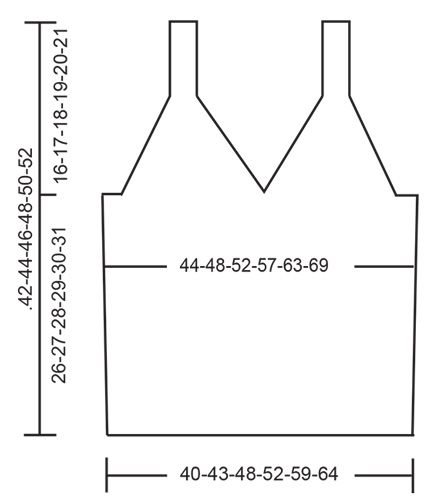
|
|
Have you finished this pattern?Tag your pictures with #dropspattern #countrycheertop or submit them to the #dropsfan gallery. Do you need help with this pattern?You'll find 10 tutorial videos, a Comments/Questions area and more by visiting the pattern on garnstudio.com. © 1982-2025 DROPS Design A/S. We reserve all rights. This document, including all its sub-sections, has copyrights. Read more about what you can do with our patterns at the bottom of each pattern on our site. |
|







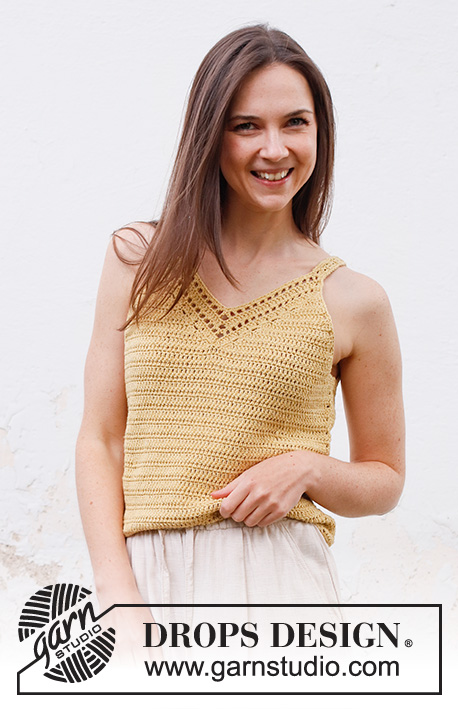

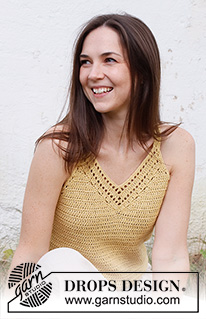
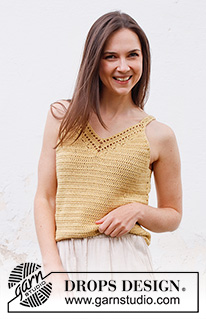

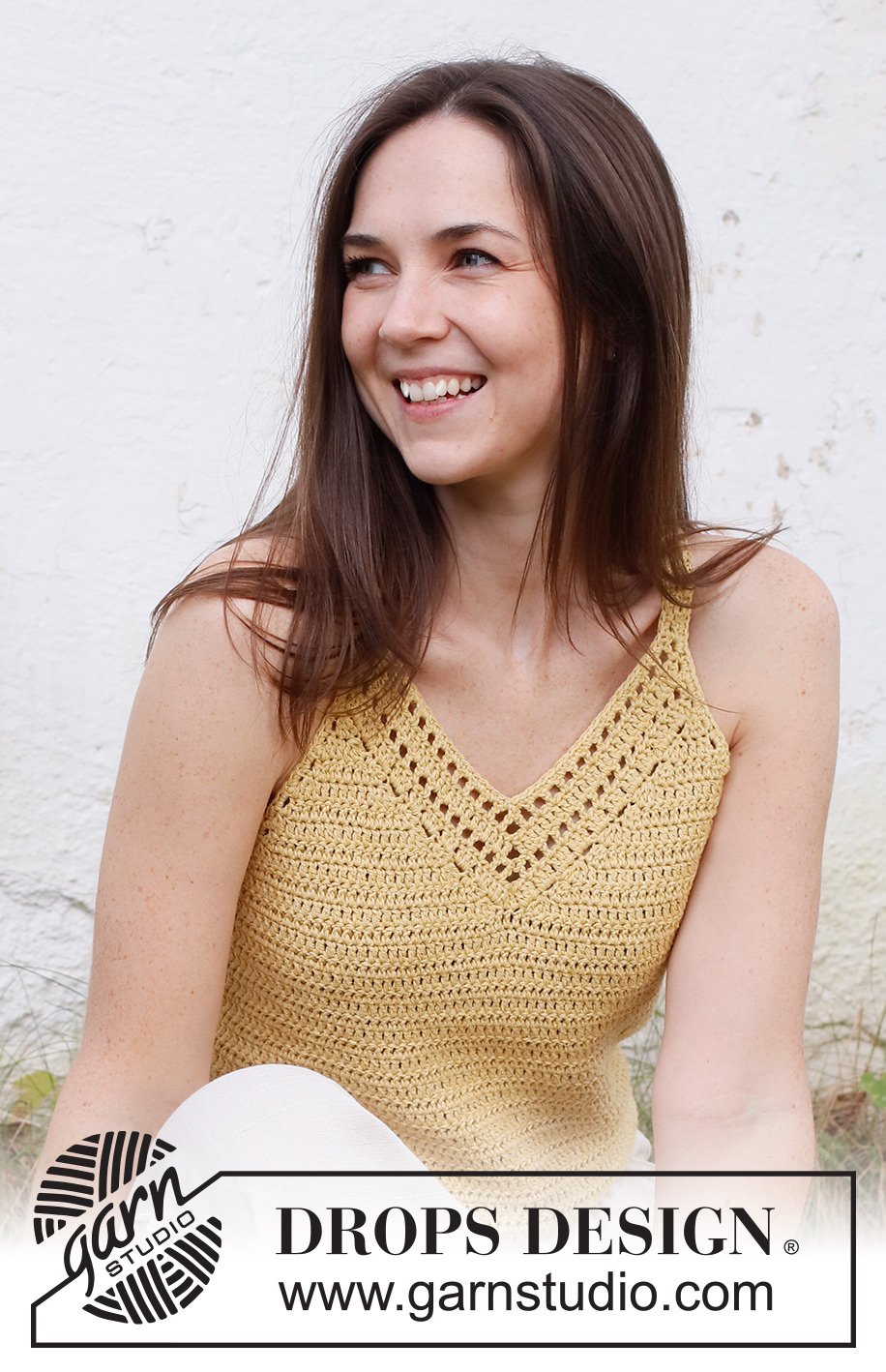
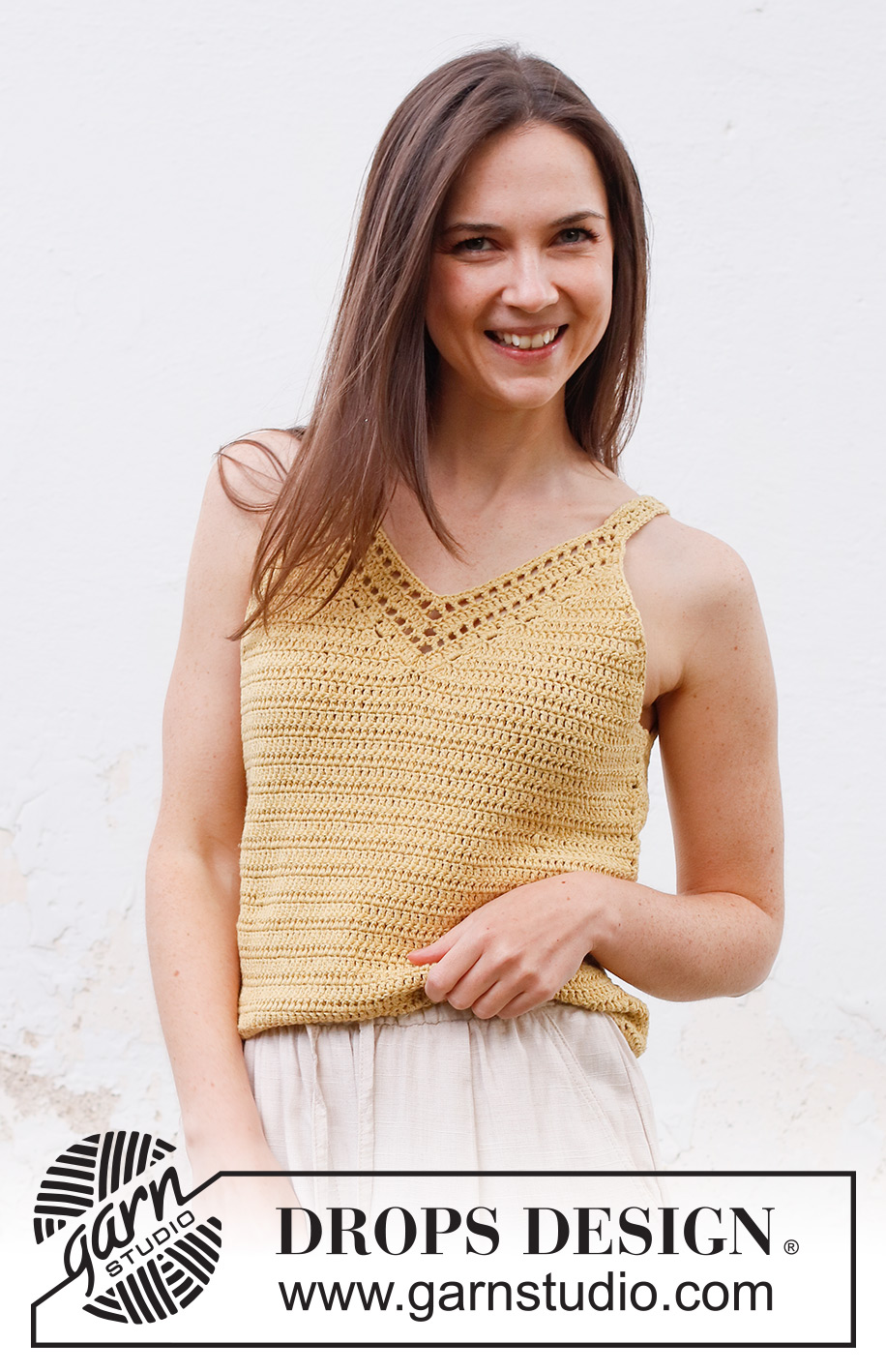




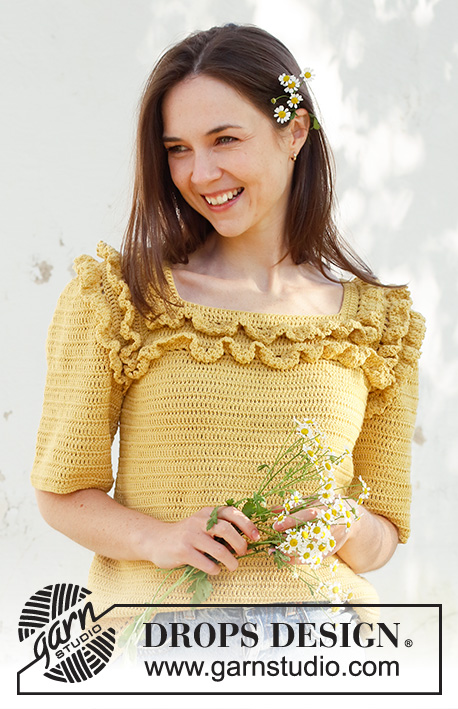


























Post a comment to pattern DROPS 231-41
We would love to hear what you have to say about this pattern!
If you want to leave a question, please make sure you select the correct category in the form below, to speed up the answering process. Required fields are marked *.